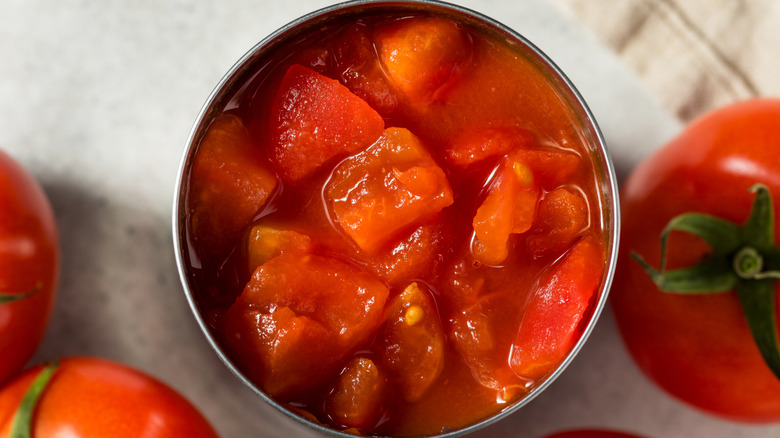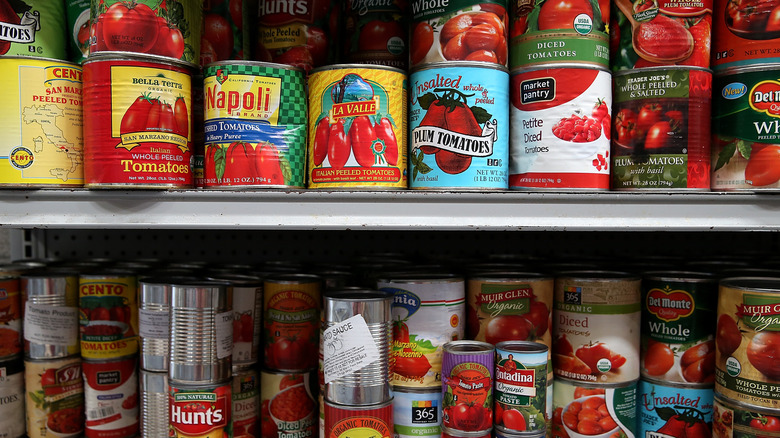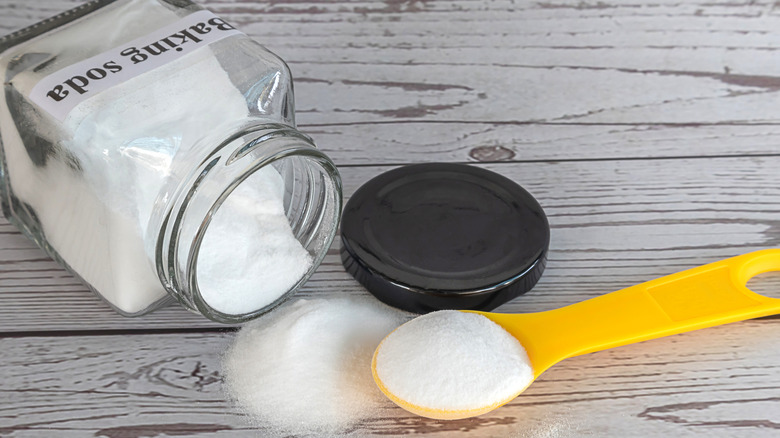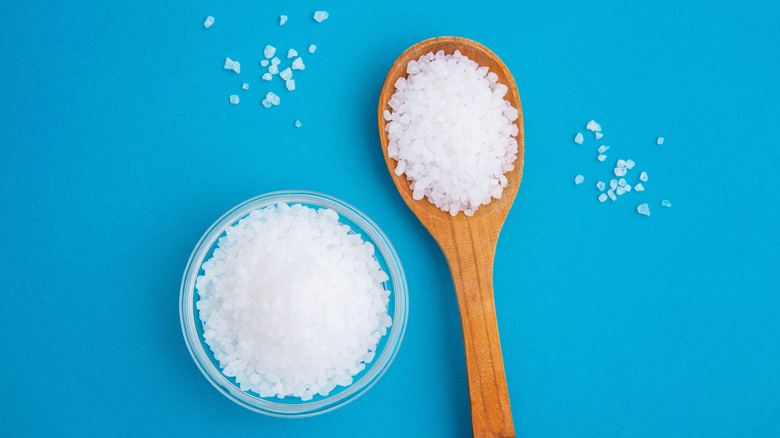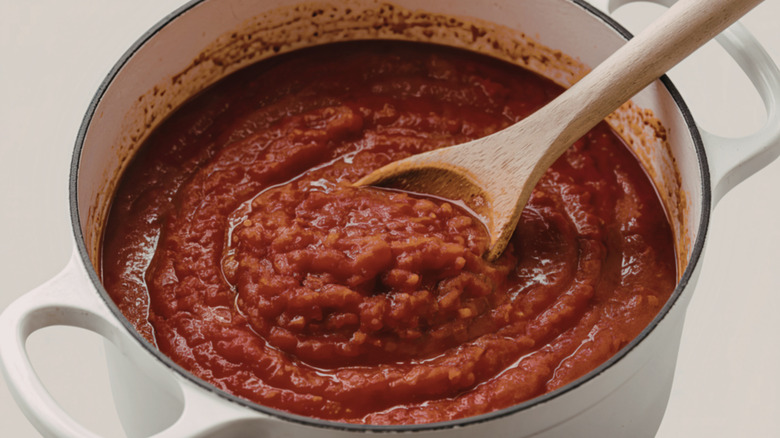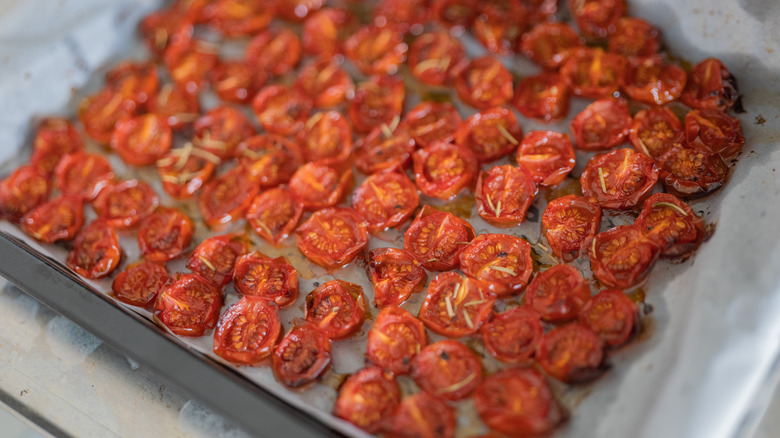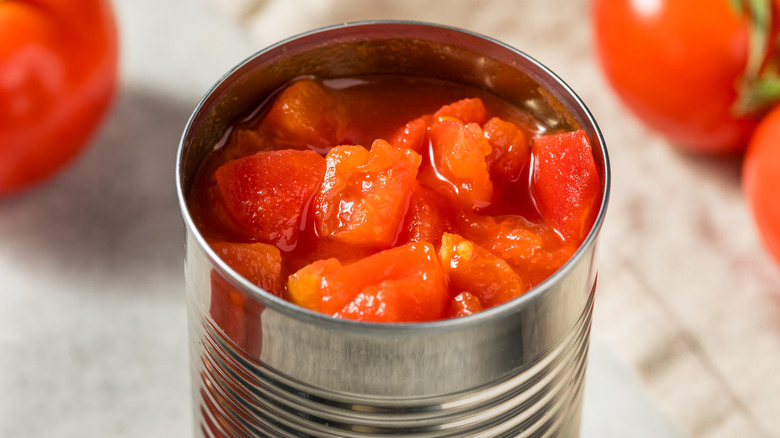The Biggest Canned Tomato Mistakes You're Probably Making
Present in numerous, globally popular cuisines and easy to grow in many climates, tomatoes are an important food for a lot of people. Packed with vitamins and nutrition, the shiny red (and sometimes purple, green, or yellow) vegetable (that's actually botanically a fruit) can be found in a variety of types, species, and sizes, like grape, cherry, plum, and beefsteak. And that's just the fresh vine-ripened kinds of tomatoes. There's a whole different world of canned tomatoes to explore.
With the right pantry staples, anyone can assemble a quick weeknight meal. Canned tomatoes, perhaps even more useful and generally cheaper than fresh tomatoes, can hang around the house for years on end, just waiting to be used in soups, sauces, chili, and so many more dishes. But as readily available, practical, inexpensive, and easy to use as canned tomatoes can be — even professional chefs use canned tomatoes — it's just as easy to misuse that tightly-packed tin of lumpy, slimy, sweet, tangy, and concentrated flavor. Here are the most common mistakes people make when it comes to canned tomatoes, and some tips on how to get the most out of them the next time you open up a tin.
Not being aware that are different kinds of canned tomatoes
There's an array of canned tomatoes, which benefits the home cook because each serves a specific set of purposes. Using the wrong kind of tomato for the job may alter or even ruin a recipe. Whole canned tomatoes are a versatile choice, often consisting of plum tomatoes of the Roma or San Marzano type (so they can fit snugly into a can) that are peeled during the production process. Left intact, they're generally the highest quality canned tomatoes across the board, and you can always blend, crush, mince, or chop them to suit your needs. You can't uncrush crushed tomatoes, though, which are placed into cans already semi-processed, meaning it takes less time for them to break down when used as the base of a sauce.
Meanwhile, diced tomatoes have been cut into small bits before being canned. To ensure they don't break down further while sitting in the can, additives and preservatives are used. Diced tomatoes are ideal for recipes where the flavor and consistency of bite-sized tomatoes are necessary. This is to say nothing of fire-roasted tomatoes, often found diced. They're flame-roasted prior to canning, which imparts a smoky, charred, and intense flavor — this is the canned tomato to use in a dish like chili.
Assuming all brands are the same
When confronted with a wall of canned tomatoes at the supermarket, one might be led to believe that they're all the same. After all, tomatoes are tomatoes, and they're a utility ingredient that's just going to get cooked down and become part of a recipe, where any flaws might be buried or overlooked. It's simply not true. There are many canned tomato brands worth buying and plenty to avoid. Differences between the name brands and generics abound, based on the type of fruit used, point of origin, and the production process. And although the more expensive canned tomatoes tend to be the best choice overall, bargain brands can be solid options too.
San Marzano tomatoes are regarded as ideal for canning. They're grown in Italy, and you can distinguish real San Marzano tomatoes from impostors by looking for a DOP indication on the label. Cento brand tomatoes are imported canned San Marzanos, whereas domestic producers use the same variety of tomato but grow them in the U.S., earning them a San Merican designation along with the benefits of their authentically Italian counterpart. Mass-produced American brands, like Contadina and Hunt's, tend to use less dense and flavorful tomatoes and bulk up cans with too much water.
Draining the liquid from the tomatoes
A can of tomatoes isn't just a can of tomatoes — the preserving and packing liquid starts as water, but over time, it absorbs bits of the fruit and its natural juices. That creates a light tomato-flavored sauce, which can be just as valuable to a recipe as the whole or cut chunks. If, out of a force of habit, you open a can of tomatoes and carefully drain off all the liquid and use just the fruit in the recipe you're making, you're losing out on an extra source of tomato flavor.
It's very easy to use tomato juice liquid. Simply pour the entire can, solids and liquids, into the pot, especially if you're making something that needs a good amount of water, like a soup or stew. The liquid can replace some of the water or stock you'd use otherwise. It also adds moisture to something thicker, like a pasta sauce. The extra bit of tomato-flavored water enhances and preserves the taste while preventing everything from drying out. But what if you just need the tomatoes after all? Save that juice to use for a recipe that needs a flavor boost.
Using fresh tomatoes instead of canned
Fruits and vegetables that come in cans have historically been burdened by the misconception that they're categorically inferior to their freshly picked and sold counterparts. There also persists the notion that fresh produce and canned alternatives are interchangeable on a one-to-one basis, and that a recipe that calls for tinned veggies will taste much better if fresh ones are used instead. There are significant differences between canned and fresh fruits and vegetables, however, particularly tomatoes.
Canned tomatoes have gone through an intense preservation process that transforms just off-the-vine tomatoes into something more concentrated and intensely flavored. There's usually a lot more flavor in a whole tomato out of a can than one from the supermarket, offering more impact for your dish. Also, canned tomatoes are far more consistent than fresh ones — you don't have to worry if they're in season, or if their peels will negatively affect a dish, because they've already been removed.
The idea goes both ways: Don't substitute canned tomatoes when the job calls for fresh tomatoes. Canned tomatoes are already cooked, and raw tomatoes obviously aren't. Using preserved tomatoes in something like pico de gallo would be inadvisable.
Forgetting to cut the acidity
Tomatoes are naturally acidic, and often the reason they're used in the preparation of so many dishes. But tomatoes can also be too acidic, which can threaten the quality of a dish or lead to health problems for those who are sensitive. There's an easy fix to reduce the acidity of tomatoes that doesn't take away any of the robust and nuanced flavor: baking soda. Most commonly used as a rising agent in baked goods, it can also be used to counteract acid. Canned tomatoes are even more acidic than fresh tomatoes, but that acid can be neutralized with the addition of an alkaline substance, and baking soda fits the bill.
Fair warning: Don't overuse baking soda. A little goes a long way, and it's best to gradually add it in small amounts to the recipe as it cooks. Begin with a pinch, stir it in, and wait for the contents to bubble. That's the acid reacting to the alkaline, and after that happens, have a taste. If it still seems too acidic, add a tiny bit of baking soda, and repeat if necessary. But don't go too far. Throwing off the balance toward alkalinity can result in tomatoes that taste foul or like soap.
Not adding sugar when you should
In addition to baking soda, there's another quick, cheap, and easy way to make a simmering pot of food heavy on canned tomatoes bend to the cook's will and specification. Baking soda can cut the acidity of those rich and concentrated tomatoes without changing the overall taste, but sugar can do the same thing while also enhancing the natural flavor and sweetness. It's actually traditional to toss just a bit of sugar into a marinara sauce, and it's commonly used in pizza sauce, too.
If you're after a deep and nuanced flavor in your tomato sauce, sugar adds a bit of sweetness to pair with the natural tanginess of the fruit. Not very much sugar is required to give tomato sauce a boost. It's recommended to add a starting pinch of the sweet stuff to a sauce in the making. Begin with a little, stir it in, and add to taste — depending on the tomatoes, you may need more, since different brands and batches may vary slightly.
Poorly seasoning your canned tomatoes
Baking soda and sugar are both effective ingredients to soften the acidic intensity of canned tomatoes, while letting the true flavor of the fruit come to the surface. Other additives can be used to really take that tomato taste over the top, including the most commonly used and useful ingredient of all: salt. While "canned goods" and "very salty" may be two phrases that pop into your head in tandem — salt is a natural and extremely old food preservation tool — shelf-stable tomatoes sold in a tin are surprisingly low on salt. Canned tomato manufacturers seem to prefer to sell tomatoes as they are, and to let home cooks decide how much salt they need on a recipe-by-recipe basis.
While an undersalted dish can be easily fixed with a post-cooking sprinkle from a shaker, there are few worse things in cooking than an overly salty meal, which is harder to correct. Start by adding a little pinch of salt, up to a teaspoon per pound of tomatoes. You might need more or less according to taste, and also because different salts behave differently. Kosher or flaked sea salt is large-grained, so there isn't as much actual salt in a spoonful as opposed to table or finely ground salt. And before you add any salt, be sure to check if the canned tomatoes have been pre-salted after all.
Forgetting that you can blend canned tomatoes
Probably the best reason to keep a variety of canned tomatoes in your pantry is that they're so versatile, and a foundational ingredient in so many home-cooked dishes. They can also be altered in any which way to meet individual expectations, and that even goes for the inexpensive, perhaps lower-quality canned tomatoes that were on a big sale and led you to stock up.
Obscure brand, store brand, or just plain second-rate canned tomatoes may not deliver what the label promises. They might be chunkier than expected, or too watery, for example. But those seemingly not-great tomatoes still contain lots of flavor, so it's up to the cook to unlock what's inside by continuing the processing that the food manufacturer didn't quite finish.
Canned tomatoes are soft and squishy and can be easily blended. A trip through an appliance for a blitzing (perhaps with a splash of olive oil) blends the tomatoes until they're smooth and have an even texture. And if you're going to use those tomatoes in a sauce, you've saved yourself some simmering time because the fruits have gotten a head-start on the breakdown process.
Failing to roast canned tomatoes
Roasting fresh tomatoes in an oven is simple; roasting canned tomatoes is even simpler. While you can certainly purchase canned tomatoes that have conveniently already been roasted, it doesn't mean that other types of canned tomatoes can't be put to the flame or heat by home cooks. Canned tomatoes aren't necessarily ready to eat and ready to go — they remain versatile and able to undergo more steps to intensify the flavor or change the texture.
The roasting process heats the tomatoes to a high enough temperature that it causes most of the water trapped inside the fruit to evaporate. That leaves behind a smaller, more compact tomato, with all of its flavor intensified into a tiny package. A freshly roasted tomato is sweeter and zestier than a fresh tomato, and a home-roasted one is even tastier than one that comes pre-roasted in a can. If undertaking this project, use whole canned tomatoes rather than diced or crushed ones and save the liquid for another meal, then roast them in the oven for around an hour at 300 degrees Fahrenheit. They're done when they darken and start to dry out.
Improperly storing leftover canned tomatoes
You don't always require the whole lot when you open a can of tomatoes, leaving you with leftovers to store. Chances are you'll probably just leave them in the can and cover it with the sliced-off lid, or fit a plastic baggie or cling wrap over the top to seal the contents before transferring the can to the fridge. While it's certainly worthwhile and noble not to waste food, that method of short-term preservation — keeping the tomatoes in the can from which they came — is all kinds of wrong.
Once the can is open, air gets in and stays in. The oxygen and the metal cause a chemical reaction with the tomatoes, which can change (and worsen) the flavor of the leftovers. It's far better to take whatever tomatoes remain and place them in a glass or plastic container with a purpose-built lid that can offer an airtight seal. Then, refrigerate the tomatoes as you normally would, and if they aren't consumed within five days, throw them out. If more tomato-based cooking isn't in the cards for the next week, freezing previously canned tomatoes is a better idea. If placed in a freezer-safe plastic bag or container that's properly sealed, those tomatoes will stay good for around two months.
Not canning your own tomatoes
The biggest mistake you continuously make with your store-bought canned tomatoes may be using store-bought canned tomatoes in the first place. If you're thinking of canning tomatoes, it's probably a great idea if you're an avid home cook who also knows their way around a garden. If you're constantly altering canned tomatoes or just using a whole lot of them, it might be easier to just have your own supply. Home-canned tomatoes can be grown, processed, and preserved according to your needs. Store them whole and peeled, finely or roughly chopped, roasted or not, or even infused with spices, herbs, and flavoring agents like basil, oregano, and garlic. Although canned tomatoes are an inexpensive purchase at the grocery store, they might taste better or have a similar cost if self-preserved.
Building up a supply of canned tomatoes isn't terribly hard, but it does require a strict adherence to the instructions to ensure the end product is safe for consumption. Jars and lids need to be sterilized (which a dishwasher can do) before being filled with blanched, peeled, and mostly cooked tomatoes, either chopped or untouched. The addition of lemon juice aids in preserving the right level of acidity, and salt can be sprinkled in to ensure flavor.

